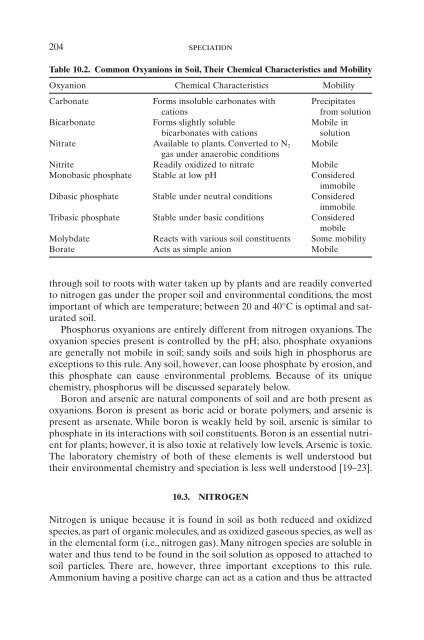Introduction to Soil Chemistry
Introduction to Soil Chemistry
Introduction to Soil Chemistry
You also want an ePaper? Increase the reach of your titles
YUMPU automatically turns print PDFs into web optimized ePapers that Google loves.
204 speciation<br />
Table 10.2. Common Oxyanions in <strong>Soil</strong>, Their Chemical Characteristics and Mobility<br />
Oxyanion Chemical Characteristics Mobility<br />
Carbonate Forms insoluble carbonates with Precipitates<br />
cations from solution<br />
Bicarbonate Forms slightly soluble Mobile in<br />
bicarbonates with cations solution<br />
Nitrate Available <strong>to</strong> plants. Converted <strong>to</strong> N 2 Mobile<br />
gas under anaerobic conditions<br />
Nitrite Readily oxidized <strong>to</strong> nitrate Mobile<br />
Monobasic phosphate Stable at low pH Considered<br />
immobile<br />
Dibasic phosphate Stable under neutral conditions Considered<br />
immobile<br />
Tribasic phosphate Stable under basic conditions Considered<br />
mobile<br />
Molybdate Reacts with various soil constituents Some mobility<br />
Borate Acts as simple anion Mobile<br />
through soil <strong>to</strong> roots with water taken up by plants and are readily converted<br />
<strong>to</strong> nitrogen gas under the proper soil and environmental conditions, the most<br />
important of which are temperature; between 20 and 40°C is optimal and saturated<br />
soil.<br />
Phosphorus oxyanions are entirely different from nitrogen oxyanions. The<br />
oxyanion species present is controlled by the pH; also, phosphate oxyanions<br />
are generally not mobile in soil; sandy soils and soils high in phosphorus are<br />
exceptions <strong>to</strong> this rule. Any soil, however, can loose phosphate by erosion, and<br />
this phosphate can cause environmental problems. Because of its unique<br />
chemistry, phosphorus will be discussed separately below.<br />
Boron and arsenic are natural components of soil and are both present as<br />
oxyanions. Boron is present as boric acid or borate polymers, and arsenic is<br />
present as arsenate. While boron is weakly held by soil, arsenic is similar <strong>to</strong><br />
phosphate in its interactions with soil constituents. Boron is an essential nutrient<br />
for plants; however, it is also <strong>to</strong>xic at relatively low levels. Arsenic is <strong>to</strong>xic.<br />
The labora<strong>to</strong>ry chemistry of both of these elements is well unders<strong>to</strong>od but<br />
their environmental chemistry and speciation is less well unders<strong>to</strong>od [19–23].<br />
10.3. NITROGEN<br />
Nitrogen is unique because it is found in soil as both reduced and oxidized<br />
species, as part of organic molecules, and as oxidized gaseous species, as well as<br />
in the elemental form (i.e., nitrogen gas). Many nitrogen species are soluble in<br />
water and thus tend <strong>to</strong> be found in the soil solution as opposed <strong>to</strong> attached <strong>to</strong><br />
soil particles. There are, however, three important exceptions <strong>to</strong> this rule.<br />
Ammonium having a positive charge can act as a cation and thus be attracted
















